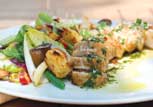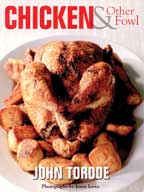

High Quality Breeds & Creative Preparations Make Poultry Less Paltry
Melissa Matarese
Sophisticated diners have shunned simplistic chicken, a basic protein that can easily be prepared at home. It is often viewed as a safe choice, alienating those seeking originality. In light of the economic downturn and emergence of superior breeds of birds such as Jidori, chefs are remaking their menu staples into dishes that attract the curious and the simple alike.
Defining the customer
Almost everyone likes chicken, but according to Executive Chef Quinn Hatfield of Hatfield’s in Los Angeles, diners can be divided into three “camps.” He explains, “On one hand, there is a group of people that would never order chicken because they are out for a nice dinner. There are those who order chicken because they are looking for something safer. Then, there are those who are looking for your weaknesses and order it to see how good it really can be.” Hence, every dish featuring chicken should be well thought through to appeal to a wide range of customers.
All in all, chicken is a great sell and chefs use their personal tastes to gauge what to serve in their restaurants. “What appeals to me will typically appeal to diners,” says Chef Hatfield. “Definitely people come in and say chicken? I would never order that here because it’s so boring! But, people who know our chicken dishes really like them and come back time after time.”
Taste that bird
Jidori chicken, a hyper-local free-range chicken with roots in Japan, is farmed in California and renowned for its unparalleled freshness. Birds are delivered within one day of slaughter with head and feet intact. “This bird is the real deal,” says General Manager Scott Watkins of Urban Solace in San Diego. “It is the freshest, most beautiful bird.”
When using fine ingredients such as Jidori, “Don’t hide it, don’t bury it, don’t overdo it. Just prepare it properly and simply,” recommends Executive Chef Matt Gordon.
Chef Andy Brooks prepares Jidori and other free-range breeds at his restaurant, Brooks, in Ventura. “Everyone is looking for organic. I don’t know who is buying chickens that aren’t natural these days. The Jidori chickens are juicy and rich with clean flavor.” Chef Brooks’ chicken is marinated in a 20-hour brine: a purée of orange juice, soy sauce, onion, garlic, smoked chilies, vinegar, white wine, cumin seeds and star anise. The breast and skin are flavored with salt and pepper, placed on the wood grill, then topped with an orange, bourbon, molasses sauce. Traditional accompaniments include roasted-garlic mashed potatoes, sautéed collard greens with roasted corn, red bell pepper, and Applewood smoked bacon.
A neutral slate for creativity
Chicken is “a blank canvas,” an excellent vehicle to bring out other flavors. In many ways “it is similar to a halibut or cod in the world of fish; there are a myriad of ways to pair it with different items,” says Executive Chef Josh Crain of Nob Hill Tavern in Las Vegas.
By creating a Mediterranean feel in the desert that is Las Vegas, Chef Crain brings cooling flavors to the Shelton Farm’s chicken couscous with apricots, almonds, Lucques olives and chicken jus. The acidity and sweetness of apricots pair with the lemon preserve of the couscous. The chicken is brined and undergoes a two-part cooking process: cooked sous vide for 20 minutes and then pan seared with herbs and butter.
At Lucques, Executive Chef Suzanne Goin has seen great success with experimentation. She crafted a play on “poule au pot,” by stuffing a chicken leg with liver that was wrapped in caulfat. She admits the end product “looked pretty crazy.” So crazy that “we in the kitchen called it the chicken ball.” Regardless, diners are addicted to the dish and Chef Goin was pleasantly surprised by its popularity.
Chef Hatfield aims to “create a different experience” for his guests. His general philosophy is to integrate flavor and texture points. “For me chicken works well into that equation.” He treats his chicken as he would treat any protein; the aim is to create a balance of texture and flavor. “When you come to a restaurant like Hatfield’s, it is good to give them something a
little bit different. We have a lot of chicken regulars.” He demonstrates his philosophy with his buttermilk-steamed chicken breast with Japanese pearl barley, chanterelle mushrooms, charred pea tendrils & tarragon emulsion that he has been serving for about 10 years. The dish captures the texture and flavor contrast that he wants to “hit on every dish.” Despite
an initially exotic sound, “the flavor profiles end up fairly familiar.”
Yes, chickens can fly
Not only is chicken a versatile protein that encourages creativity, but it is also a cost-effective choice that might just be the most affordable dish for those scanning dollar signs. “It is a cheaper product and the economy is surging towards using cheaper, easier ingredients; so, chefs are getting creative with it,” says Chef Jimi Lasquete at Evan’s American Gourmet Cafe in South Lake Tahoe. After removing the breasts, bones and carcasses, Lasquete uses these flavorful components as the base for soups, stocks, sauces and vinaigrettes.
Hatfield’s Bar is also cognizant of chicken economics. Chef Hatfield offers popular chicken tenderloins, a byproduct of the buttermilk chicken breast dish. “We cook the chicken breast with the tenderloin still attached, pull it off, and serve the breast in the dining room and take the tenderloin and panko bread and fry it; it comes out excellently with the buttermilk flavor, yet is tender and crispy on the outside.”
“So many people are ordering chicken now, it is unbelievable. Locals and tourists from all over the world come in to order our chicken. Some will visit four times in one week, on two of which they will order our chicken,” says Lasquete. This popularity is similarly reflected at Urban Solace where the roasted chicken is its top seller, flying out the door.
A modern twist to traditional favorites
Inspired by traditional recipes, chefs are constantly trying to discover combinations that “surprise and wow.” Diners need to feel that their order is different from the chicken they could cook at home.
At Urban Solace, Chef Gordon reinterprets the classics by using Jidori chicken. His two chicken-
focused dishes embody “a reinterpretation, yet homage to the originals.” Buttermilk Dumplings with savory chicken gravy and fried sage takes a twist on familiar, southern comfort fare. Butternut squash, white sweet potatoes and carrots are sautéed with succulent, pulled, Jidori meat. Buttermilk dumpling dough simmers in the chicken and vegetable concoction to which the chicken gravy is added to create a hearty, warming meal.
The number one seller at Urban Solace is the maple whiskey natural half chicken, served with sweet potato fritters and market vegetables. To Chef Gordon, a true test of a chef is how he or she can roast a chicken. “Frankly, it is really hard to do right. Honestly, most don’t. When chicken is done right, it can be as awe-
inspiring as duck, filet mignon or foie gras.”
Customers at Lucques would agree with Chef Gordon’s sentiments on chicken’s gourmet potential. Lucques’ saltimbocca with sage and prosciutto sautéed in brown butter with a Madeira reduction and the chicken paillard that is dredged in parmesan breadcrumbs and pan-roasted are both huge hits with diners. “It is like fancy fried chicken,” that appeals to both children and adults.
Both Chef Lasquete at Evan’s Gourmet and Chef Eric Berg at the Restaurant at Wente Vineyards, Pleasonton, pair their chicken entrees with panzanella accompaniments, but add a twist to this staple side dish. Lasquete offers his take on tradition with his eye-catching herb and panko-crusted breast of chicken with jus de volaille, mascarpone risotto, edamame, panzanella salad with green beans. “This is a comfort dish, but takes people to a different level of comfort.” He cautions against chicken preparations that “go bold on flavors” that might “intimidate the customer.”
What sets Wente’s chicken apart from other typical preparations is Eric’s interpretation of summer roulade. Mary’s Farm Chicken Roulade is accompanied by chicory panzanella, roasted peppers, pole beans and finished with salsa verde. To create the roulade, chicken bones are removed first. Then, the skin is separated so that the breast meat can be folded over the dark meat and wrapped within its own skin to maximize juiciness. The chicken is tied, plastic wrapped, poached, and pan finished to achieve a crispy skin. The chicory, panzanella salad also includes frisée, radicchio, endive and arugula tossed in olive oil. House- made sourdough is dressed with white balsamic vinaigrette and tossed with fresh peppers and eggplant. The dish is weaved together with a salsa verde of parsley, chive, cilantro, sundried tomato, capers, chopped anchovy, extra virgin olive oil, salt and pepper.
Fresh and simple ingredients
Regardless of approach, avant-garde or home-style, the message is consistent: stick to familiar flavors that create the unique restaurant experience, an experience that could not be created in the home. Success of a chicken dish is dependent on the quality of the meat, so first and foremost, “find yourself a good chicken. You can’t make a bad chicken much better,” recommends Chef Crain. And just remember, despite the existence of chicken critics, “You would be hard pressed to find something that doesn’t taste good with chicken.”
Melissa Matarese is a chicken lover, consuming it both in and out of her home. She is currently pursuing her MBA at Harvard Business School and also holds degrees from Johns Hopkins University and the University of Cambridge. Melissa writes about the New York Dining Scene on her Blog: L’Epicurien of View From the Front Row.


John Torode
Firefly Books
2010
$24.95
Often tucked away within the inner confines of cookbooks are recipes for the humble chicken. The pedestrian bird gets the royal treatment as the focus of John Torode’s latest book: Chicken & Other Fowl. Known for his two hugely popular restaurants in London and as a presenter on England’s MasterChef series, Chef Torode knows his way around a bird.
His book is filled with over 250 recipes for chicken, guinea fowl, partridge, pheasant, goose, duck, grouse, pigeon, squab, quail and turkey, drawing on influences from around the world. Full page photographs throughout make this a great source of inspiration for the chef looking to liven up the poultry section of a menu. The bright and spicy flavors of Thailand come through in his jungle curry of guinea fowl and ground chicken on lemongrass recipes, while the roast grouse with Madeira sauce and the pheasant wrapped in prosciutto with polenta lean toward the more traditional continental flavors.
